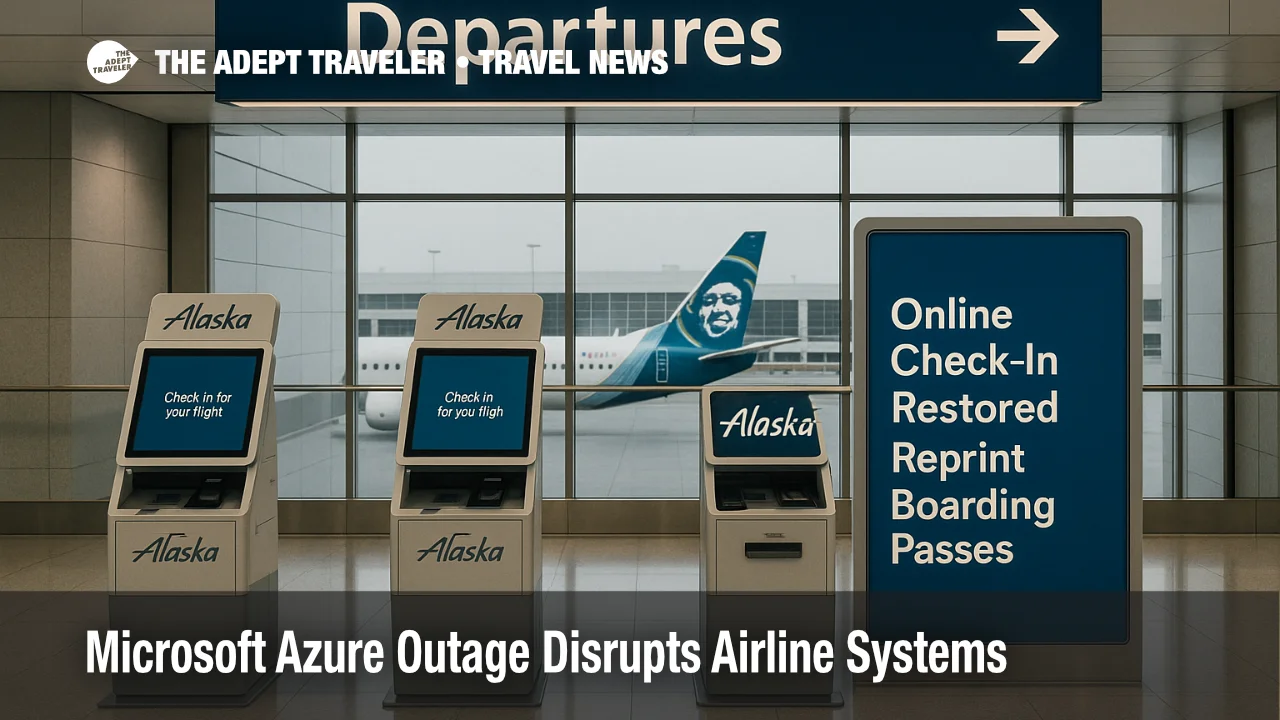Microsoft Azure Outage Disrupts Airline Systems

Key points
- Microsoft deployed a fix for an Azure portal outage on October 29, 2025
- Alaska Airlines and Hawaiian Airlines saw website and check-in disruptions
- Air New Zealand reported delays tied to payments and digital boarding passes
- Microsoft 365, Xbox, Minecraft, Costco, and Starbucks were also impacted
- Most services recovered by late evening but some issues lingered
Impact
- Expect Delays At Check-In
- Leave extra time at the airport if your airline reported website or app issues
- Have Offline Backups Ready
- Carry printed or downloaded boarding passes and proof of payment
- Watch For Waivers
- Monitor your airline for change-fee waivers or flexible rebooking options
- Try Alternate Channels
- If the app fails, use mobile web, airport kiosks, or call centers
- Reconfirm Payment Status
- If you purchased extras during the outage, verify charges and receipts
A widespread outage in Microsoft's Azure cloud on October 29, 2025, rippled through parts of the travel industry, temporarily degrading critical airline systems such as websites, mobile apps, check-in, payments, and digital boarding passes. Microsoft said the incident, linked to Azure Front Door and a configuration change, also degraded access to Microsoft 365 and consumer services like Xbox and Minecraft. By late evening, the company reported recovery toward pre-incident performance, though some customers still saw residual issues. For travelers, the net result was slower digital processes, spotty check-in functionality, and the potential for lines at airport counters.
Airlines most affected
Alaska Airlines said the Azure platform was at the heart of disruptions to several of its services, including the website and online check-in. The carrier stood up backup infrastructure to keep bookings and check-in available, then began bringing primary systems back as Microsoft mitigated the outage. The incident followed an unrelated internal IT failure less than a week earlier that triggered a ground stop and hundreds of cancellations, underscoring how repeated technology shocks compound operational risk.
Hawaiian Airlines was referenced alongside Alaska in local reports of website disruption tied to the global Azure event. While flight operations continued, degraded digital tools can still slow airport processing and increase call-center volumes, especially during peak banks.
In New Zealand, Air New Zealand warned travelers to expect delays because it could not process payments or digital boarding passes during the outage window, illustrating how cloud dependencies can impair day-of-travel checkpoints far from an airline's core data center. National outlets also reported knock-on effects across government sites.
Latest developments
Microsoft said it deployed a fix and rolled back the problematic configuration causing impact to Azure Front Door, a global content and application delivery network that underpins both enterprise and consumer services. External trackers showed elevated error reports for Azure and Microsoft 365 during the peak, returning toward baseline later in the day. Industry reporting also cited dependency chains that widened the blast radius to retailers and hospitality brands including Costco and Starbucks, which mirrored the airline experience, with point-of-sale and customer apps feeling strain.
Analysis
For travelers, cloud outages rarely ground airplanes by themselves, however they slow everything that touches customer data, from seat changes and payments to bag fees and boarding passes. The most visible symptoms are longer lines at counters and kiosks, slower reissues during irregular operations, and a higher chance of missed ancillary purchases because merchants cannot process payments quickly. When multiple providers rely on the same cloud edge, like Azure Front Door, the disruption can synchronize across brands, amplifying the perceived scale even when flight operations continue.
How it works. Most airline digital channels depend on cloud front ends that authenticate users, serve dynamic content, and proxy requests back to reservation and departure-control systems. If the content-delivery or identity layer is impaired, apps and websites may time out, even if the core passenger systems remain reachable. Airlines maintain fallback paths, for example mobile web instead of app, airport kiosks, and manual document checks. During Wednesday's event, Alaska said it activated backup infrastructure to sustain bookings and check-in, a common resilience measure that reduces, but does not eliminate, customer friction.
What to do next. If you are booked this week on an airline that reported Azure-related issues, re-download your boarding pass once systems are stable, and carry an offline copy. Bring the credit card used for purchases in case payment verification is required. If you attempted an add-on, like a seat, bag, or lounge purchase during the outage window, review your email and statement to confirm success, and contact the airline if a receipt is missing. Watch airline alerts for temporary change-fee waivers that sometimes follow tech disruptions, especially when paired with weather or crew constraints.
Final thoughts
The Microsoft Azure outage shows how a single configuration error at the edge can slow the travel journey worldwide, from check-in pages to boarding-pass scanners. Travelers who keep offline backups and verify payments after a major outage will move faster when systems wobble. Primary keyword placement, Microsoft Azure outage, remains central to the story and aligns with traveler utility.
Sources
- Microsoft deploys a fix to Azure cloud service that's hit with outage, The Associated Press
- Microsoft Azure's services restored after global outage, Reuters
- Alaska Airlines says website, app down amid global Azure outage, Reuters
- Microsoft says it is recovering after Azure outage took down 365, Xbox, and Starbucks, The Verge
- Live: Major Microsoft outage disrupts websites around world, RNZ
